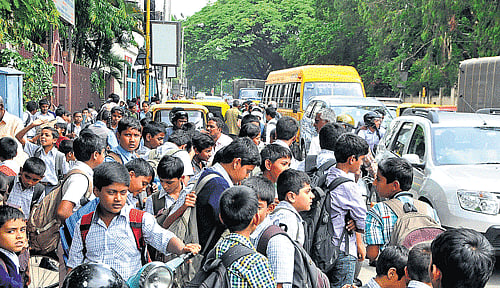
The unrelenting noise from the rising vehicular traffic around schools in the City has an immediate cause for worry:
Reduced attention span and memory in elementary school children, as established again by a recent study conducted in partnership with the Karnataka State Pollution Control Board (KSPCB).
The effect of traffic noise was studied on two groups of children in the City. One, exposed to noise levels of 80.4 dB (decibels) and the other group learning in a noise environment of 56.28 dB.
Both the groups were matched for age, gender, intelligence and socio-economic status.
“On analysis of the data, it was found that attention, working memory with an auditory component and logical memory were significantly reduced in the group exposed to high noise levels,” concluded Dr Kahkashan Azeez in her research findings submitted to KSPCB and the Rajiv Gandhi University of Health Sciences (RGUHS).
Lesser resources
Noise generally increases the demands on the limited capacity of a child’s attention and information processing powers. Simply put, this implies the child has much less resources to make sense of information from his or her memory.
The study, which covered a critical mass of children in the age group of seven to 11 years, indicated that traffic noise was significantly associated with poor logical memory scores.
This finding was a confirmation of earlier studies that had attributed decreased motivation in school children to chronic exposure to aircraft noise.
The serious impact of noise on children’s health and development in schools thus established, the study has made a number of critical recommendations: Consider noise-associated problems while planning school buildings; design environmentally sustainable buildings that minimises noise and thus assist education goals; prepare the internal layout of the school in such a way that classrooms are not directly exposed to high levels of external noise, such as road traffic. It is already established that continuous exposure of noise in the range of 85 to 90 dB can lead to progressive hearing loss, even among adults. Children are more vulnerable to noise because of its potential to interfere with the learning process at a critical development stage.
Young ones have even less capacity to anticipate, understand and cope with noise, as reiterated by researcher Azeez.
WHO limit
The World Health Organisation (WHO) specifies that the permissible noise level in a school environment should not exceed 35 dB. But, this limit is unlikely to be met unless a Noise Monitoring Network is developed in the country.
A delayed effort was made last year, when it was decided to include ambient noise as a regular parameter for monitoring in specified urban areas.
In Bangalore, it was proposed to set up 10 continuous monitoring stations, five of which have already been installed. Ambient noise monitored from these stations show that the levels exceed the limits by 12 to 71 per cent.
